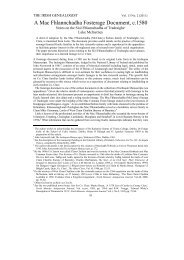Report Cover Vol I - Clare County Library
Report Cover Vol I - Clare County Library
Report Cover Vol I - Clare County Library
Create successful ePaper yourself
Turn your PDF publications into a flip-book with our unique Google optimized e-Paper software.
The <strong>County</strong> <strong>Clare</strong> Wetlands Survey Patrick Crushell & Peter Foss 2008<br />
_______________________________________________________________<br />
(Rhynchospora alba), cotton grasses (Eriophorum angustifolium, and the much rarer E. gracile), Creeping<br />
Bent (Agrostis stolonifera), Purple Moor-grass (Molinia caerulea), and a range of broadleaved wetland<br />
herbs such as Bogbean (Menyanthes trifoliata), Marsh Pennywort (Hydrocotyle vulgaris), Lesser<br />
Spearwort (Ranunculus flammula), Marsh Cinquefoil (Potentilla palustris) and Marsh Lousewort<br />
(Pedicularis palustris). Extensive moss cover is characteristic; Sphagnum spp., Calliergon spp. and<br />
Scorpidium scorpioides are usually abundant.<br />
Links with Annex I: Corresponds to the annexed habitat, 'transition mires and quaking bogs (7140)'<br />
W Woodland and Scrub<br />
This section groups habitats in which the predominant structural element of the vegetation is provided by<br />
trees, shrubs or brambles. It includes almost all types of woodland and scrub - natural, semi-natural or<br />
planted - in urban and rural situations, with the exception of woodland or scrub associated with sand<br />
dunes (See dune scrub and woodland - CD4) and commercial orchards or tree nurseries (See<br />
horticultural land - BC2). Linear boundary features that are dominated by trees and shrubs are also<br />
included in this section.<br />
Woodland is defined here as any area that is dominated by trees, as opposed to shrubs, and where the<br />
canopy height is greater than 5 m, or 4 m in the case of woodland in wetland areas or on bogs. The<br />
canopy may be open but should be distinct. Scrub or transitional woodland includes areas that are<br />
dominated by shrubs, brambles and stunted or immature trees, and where the canopy height is less than<br />
that outlined above for woodland. Note that birches (Betula spp.), Hazel (Corylus avellana) and some<br />
willows (Salix spp.) can occur both as trees and shrubs. Sessile Oak (Quercus petraea) may also occur in<br />
stunted form in exposed locations. Areas that are dominated by young or sapling trees (with the<br />
exception of most stands of planted conifers) are categorised as immature woodland - WS2. The<br />
categories, hedgerows - WL1 and treelines - WL2, should be used for any linear strips of woodland or<br />
scrub that are less than 4 m wide.<br />
The main subdivision in the woodland section is between semi-natural woodlands and all other woodland<br />
types, including commercial plantations. Natural or 'ancient' woodland vegetation is now very rare in<br />
Ireland and most stands of trees have been modified and managed to some extent by humans over<br />
centuries. Because of this, the term 'semi-natural' is generally used for stands that resemble the<br />
potential natural woodland cover. To be considered as semi-natural, woodland should be dominated by<br />
native trees, the understorey should be reasonably well-developed, and there should be no systematic<br />
removal of timber, dead wood or fallen trees. Stands that originate from planting in the past may be<br />
included if they are now regenerating naturally, as may stands that were formerly coppiced. Some<br />
common non-native broadleaved trees that occur in Irish woodlands include Beech (Fagus sylvatica),<br />
Sycamore (Acer pseudoplatanus), limes (Tilia spp.), Horse Chestnut (Aesculus hippocastanum), Spanish<br />
Chestnut (Castanea sativa) and Hornbeam (Carpinus betulus). Yew (Taxus baccata) and Scots Pine<br />
(Pinus sylvestris) are the only conifers that can be considered native to Ireland; the latter has been<br />
widely re-introduced following a major decline and possible extinction in prehistoric times.<br />
Seven types of semi-natural woodland are recognised. Most other woodland stands, except conifer<br />
plantations, can be classified in three general woodland categories that are subdivided on the basis of the<br />
different proportions of broadleaved trees and conifers that are present. They include various stands of<br />
native and non-native trees that were planted for a variety of reasons including commercial timber or<br />
energy production, landscaping, shelter or conservation in rural and urban areas. Broadleaved and mixed<br />
plantations are included, as are other stands of trees that may have originated naturally but do not meet<br />
the criteria for semi-natural woodland above. In the case of broadleaved or conifer woodland categories,<br />
the term 'mixed' should be used in the title if a number of different species contribute significantly to the<br />
canopy. Conifer plantations are considered separately and are defined here as dense stands of planted<br />
conifers where the overriding influence is commercial timber production. The proportion of conifers<br />
should exceed 75%. All other plantations should be considered in the general woodland categories.<br />
WN Semi-natural Woodland<br />
WN4 Wet pedunculate oak-ash woodland<br />
This type of woodland is associated with areas that are flooded or waterlogged in winter but which dry<br />
out in summer. It occurs on periodically-flooded alluvial sites that are well above the limits of regular<br />
inundation, and on drumlins and other sites with heavy, poorly-drained clay soils that are subject to<br />
waterlogging. Woodland is dominated by Pedunculate Oak (Quercus robur) and/or Ash (Fraxinus<br />
excelsior); other common components include Hazel (Corylus avellana), Hawthorn (Crataegus<br />
116
















